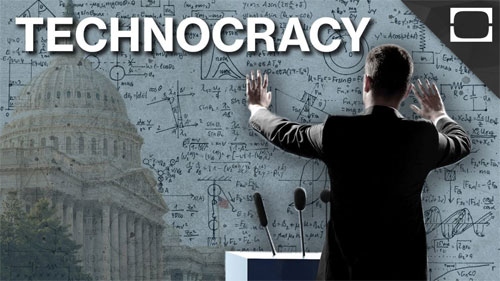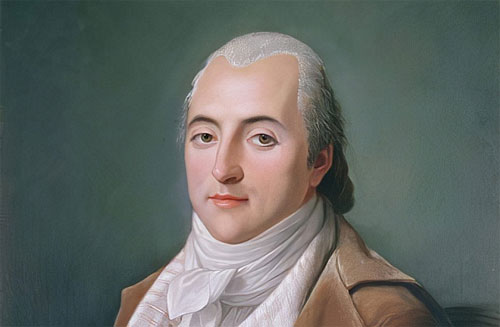The Pressing Dangers Of Technocracy (1)
Patrick M. Wood — an economist, financial analyst and American constitutionalist — has devoted a lifetime to uncovering the mystery of what is controlling most of the craziness we’re currently seeing, and which has been exacerbated by the COVID-19 pandemic.

He’s written two books on this topic: “Technocracy Rising: The Trojan Horse of Global Transformation” and “Technocracy: The Hard Road to World Order.”
“I think that’s a really important takeaway for readers,” Wood says. “Don’t just confine your view to the microcosm, like what’s in front of you. Always try and look for the big picture … Once you have the big picture, it’s hard to unsee it. Once you see it, it’s hard to not see it. It guides everything else you do within your life at that point, and that’s really important.
It’s certainly important in medicine, because if a doctor or researcher doesn’t really understand the whole picture, how can he understand a little part of the picture when you get right down into some nitty-gritty detail? It’s very difficult.”
Wood’s foray into the ideology of technocracy began with a chance meeting with Anthony Sutton at a gold conference in the early 1970s. Sutton has written several books about political science, primarily about the Trilateral Commission, which Wood had studied from a financial angle. They developed a relationship and eventually wound up collaborating on a newsletter and two books, “Trilaterals Over Washington: Volumes 1 and 2,” which have recently been re-released.
Definition of Technocracy
So, what is “technocracy”? As explained by Wood, technocracy is a movement that got started in the 1930s during the height of the Great Depression, when scientists and engineers got together to solve the nation’s economic problems. It looked like capitalism and free enterprise was going to die, so they decided to invent a new economic system from scratch.
They called this system “technocracy.” It was to be a resource-based economic system. Rather than basing the economic system on pricing mechanisms such as supply and demand, this system is instead based on energy resources and social engineering. In a nutshell, under this system, companies would be told what resources they’re allowed to use, when, and for what, and consumers would be told what to buy.
“They actually proposed to use an energy script instead of money, and let energy be the determining factor on what was produced, bought and sold, and consumed, and so on. But being engineers and scientists, in 1938 when this definition came out, which I’m going to read, they had capsulized what they viewed as the scientific method and the scientific approach.
It’s important to see that today, because we see the same subtleties, the same mindsets, the same thinking processes that they had back then. I will contend that’s a very dangerous thing. It’s a dangerous thinking process. But here’s what they concluded in 1938:
‘Technocracy is the science of social engineering. The scientific operation of the entire social mechanism, to produce and distribute goods and services to the entire population.’
First off, you’ll see that it’s the science of social engineering. That ought to be enough to make the hair stand up on the back of your head, because who wants to be scientifically engineered by somebody that you don’t know, somebody that doesn’t know you, but rather has this idea that they can reform you, remake you?
But most importantly, you see the economic aspect that they had in consciousness, the scientific operation of the entire social mechanism — that’s all the people in society — to produce and distribute goods and services to the entire population.
This was an economic system from the get go, not a political system. And what’s really important to see in that — the big takeaway here — is that technocracy viewed politics and politicians as an unnecessary, irrelevant, and even just a stumbling block to getting on down the road with society. They proposed to get rid of all the politicians. Just dismiss them. Dismiss the Senate, the Congress, all the elected officials. They basically wanted to set up an organization chart, like a corporation would have today, where you have the president and you have vice-presidents doing different things. Then you have directors over certain departments and so on. And they would just disappear the political system per se, leaving no citizen representation of government. Of course, that means the Constitution [is] immaterial, too, because that defines the political structure.
In fact, they openly called on FDR to declare himself dictator, so that he could just implement technocracy. He didn’t take them up on it. We can thank God for that. We only got the New Deal instead. By comparison, it’s much better… So, this was the genesis of technocracy and technocrats.”
Scientists Stand Above All Other Individuals
As explained by Wood, the technocrats “had this crazy idea that they were better than everybody else.” This philosophy and mindset can be traced back to Henri de Saint-Simon, a French philosopher from around 1800. Saint-Simon is considered the father of scientism, social sciences, transhumanism and technocracy.

Henri de Saint-Simon
He said in one of his essays, “A scientist … is a man who foresees. It is because science provides the means to predict, that it is useful, and the scientists are superior to all other men.” This was the mindset of technocrats in the 1930s, and it’s the same today. In essence, science is used to manipulate society and keep the economic engine running.
Top Technocrats Rescued Through Operation Paperclip
While technocracy began in the U.S., the first country to ever implement it was Nazi Germany under Hitler. However, it’s important to realize that technocracy is not Republican or Democrat. It’s not Marxist or Capitalist. It’s not a Nazi philosophy. It’s an independent ideology.
When technocracy first began in the U.S., it was a membership organization. At its peak, there were more than 500,000 card-carrying, dues-paying members in the United States and Canada. Incidentally, the head of technocracy in Canada was the grandfather of Elon Musk, founder of Tesla and SpaceX. Around the same time, a technocratic organization also got started in Germany.
“As Hitler rose to power, he realized that the technocrats, as an organization, would be competitive with him becoming a dictator. So, he outlawed the Technocratic party in Germany. At about the same time, technocracy was outlawed in Canada [for two years]. For a number of reasons, they thought that somehow the two were connected and that technocracy in Canada would be supporting Hitler …
It was discovered later by historians that these technocrats, who were banned from meeting, were actually very active during the course of World War II, during Hitler’s reign. They were the statisticians, the mathematicians, the physicists, the engineers for business and so on; that really enabled Hitler’s expansion and dictatorship. That’s not to say that they were all in lockstep with his goals, but they had a good time supporting all those things, because they were highly prized by Hitler and his leadership.
During the war, they found out also that these technocrats were communicating between the columns of power in Nazi, Germany. Hitler was rather paranoid about keeping all of those different areas separate so they would not communicate, but they did communicate during the war.
After the war … a top-secret operation [took place] in the United States … called Operation Paperclip, which brought some 1,200 of these top scientists and engineers from Germany to the United States. They sanitized their resumes and installed them into positions of scientific prowess in the United States, like at the national technology agencies.
So, the very same people that were helping Hitler do what he did, completely bypassed the Nuremberg trial. Some of them should have been there, I’m sure. But they were brought to the United States and given high positions of prestige, to continue to practice their science and engineering.”
Beauty and the Beast
The Trilateral Commission’s co-founder Zbigniew Brzezinski, a Columbia University professor, brought the concept of technocracy into the Commission in 1973, with the financial support of David Rockefeller.
“Brzezinski wrote this book called ‘Between Two Ages — America’s Role in the Technetronic Era.’ It caught Rockefeller’s eye. And so, Rockefeller and Brzezinski became like the beauty and the beast. They went on to form the Trilateral Commission, which declared, from Day 1, that they wanted to foster a new international economic order.
They said that repeatedly in their literature, and this is what got Sutton excited, and me too. What is this new international economic order you’re talking about? What do you mean? We have an economic order. It seems to be working. Why do you want to change everything? What is your idea here?”
The Trilateral Commission more or less took over the Jimmy Carter administration, and has dominated the political structure ever since. Regardless of their party affiliations, U.S. presidents have been members of the Trilateral Commission. Carter, Ronald Reagan, George H.W. Bush and Bill Clinton were all members. Within two weeks of his inauguration, Barack Obama appointed 11 Trilateral Commission members to top-level positions in his administration, equivalent to 12% of the Commission’s entire U.S. membership.
The ramifications of this are described in Wood’s article, “Obama: Trilateral Commission Endgame.”
“What happened here is that they were after the mechanism, because America was the greatest economic engine in the world at that time,” Wood explains. “They wanted to get control of the economic engine of the world so that they could manipulate it for their own benefit and convert it, transform it if you will, into technocracy …”
Personal Freedom Is the Enemy of Technocracy
It’s important to realize we’re fighting an enemy that has literally spent the last several generations compiling their power base. They’ve done it progressively, slowly and very consistently over time with the endgame in consciousness at all times. They engineered circumstances that allow them to amass more and more power.

What the technocrats are doing is making an end run around national sovereignty. Rather than a frontal assault on the system, which has never been successful, they’ve simply eroded national sovereignty piece by piece.
Their last great power grab in the U.S. was the 9/11 tragedy. It allowed them to push through the Patriot Act, which sacrificed many of our freedoms in one fell swoop. They’re in the process of doing it again with the current pandemic. It’s quite clear the pandemic is being used to move us toward an authoritarian tyranny.
However, the COVID-19 pandemic has provided a platform that will dwarf their 9/11 power-grab and radically increase their ability to continue to erode our civil liberties and control our society. If you find this line of reasoning interesting, you will enjoy the video below from Really Graceful, which reviews whether or not you’d even notice if you were living under tyranny.
Technocratic Infrastructure
It’s also crucial to understand that the only reason they’ve not yet been able to overtake the U.S. is because of their Constitution.
“The strategy has been to build infrastructure for their system. Infrastructure is the schematic diagram that makes things work. For instance, we have roads in our country. We have railroads. We have physical roads. We have freeways. We have telecommunications systems. We have telephone lines. We have airports and things that connect everything together.
The concept of infrastructure is basic to any economic system. You have to have some type of infrastructure, so that the whole system will work. And so, today when the government passes a $2 trillion infrastructure bill, you and I will think, ‘Oh, finally, we’re going to get those potholes fixed on our street or something.’
In the technocrat consciousness, in the larger scheme, setting up the infrastructure involves so many more things today than it ever did.
For instance, the infrastructure of technocracy now has to do with anything called smart: smart growth, smart cities, smart phones, smart devices, the internet of things that ties everything together, all of the sensors and the cameras. This is the new infrastructure of the digital era. It’s all technology based, I might add.
So, infrastructure started way back when the Trilateral Commission was first started. A case in point: One of the early founding members of the commission was [the late] Caspar Weinberger, who happened to be the president of Bechtel Engineering. That’s the largest private engineering company in the world. They’re huge. They’re are private. Nobody knows much about them. But they were part of the Trilateral Commission group…
They’ve always realized that without building this infrastructure, they have nothing. They can get nowhere. They must have it in order to move on down the road. We’ve seen this emphasis on infrastructure ever since 1973 in ways that people hardly can understand anymore, because it’s so technological.
But the infrastructure being laid today includes such things as the internet of things, where sensors and everything connect together to feed data back to, who knows, some mainframe somewhere.
All of the financial transactions, all of the data transactions [get sent] back to some computer somewhere where artificial intelligence is sitting on top of it all to make sense of all the data coming in.
The same artificial intelligence programs now are taking that data, working it, getting some sense of meaning out of it, then turning around and issuing things that we should do in response. In other words, how it should change us.
This is the science of social engineering. It’s engineering by algorithm. They saw this even back in the 1930s, even though there was no such thing as artificial intelligence back then.
They realized that science eventually would be to the point where their algorithms could be automated to the point where they would be able to replace the political structure, to keep everything in line, to keep everything working.
Rule by algorithm. Operation by algorithm. This is the big predominant thing we see today. When something doesn’t fit into the algorithm, you’ll hear the term ‘Science says.’ We should do that thing.”
To give you just one rather hilarious real-world example of the technocratic “science says” strategy, here’s a sentence from a recent article in The Sun: “People who refuse to wear a face mask to reduce the risk of coronavirus have lower cognitive ability, new research has found.”
Not only is it laughable because it’s illogical, it’s also completely irrelevant, since there’s not a single well-designed study showing that mask wearing lowers the spread of viral infections.
Read the second part of the article
yogaesoteric
September 18, 2020
